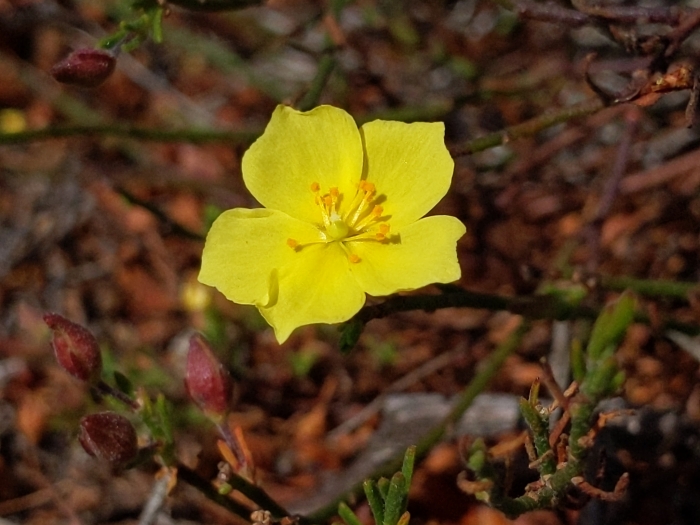Bisbee Peak Rushrose
(Crocanthemum scoparium)
Bisbee Peak Rushrose (Crocanthemum scoparium)
/
/

Ken-ichi Ueda
CC BY 4.0
Image By:
Ken-ichi Ueda
Recorded By:
Copyright:
CC BY 4.0
Copyright Notice:
Photo by: Ken-ichi Ueda | License Type: CC BY 4.0 | License URL: http://creativecommons.org/licenses/by/4.0/ | Rights Holder: Ken-ichi Ueda | Publisher: iNaturalist | Date Created: 2021-09-11T18:35:52Z |



















































Estimated Native Range
Summary
Crocanthemum scoparium, commonly known as Bisbee Peak Rushrose, is a semi-deciduous subshrub native to the chaparral and coastal sage scrub of California and the desert areas of Northwest Mexico. It typically grows to a height and width of 0.2-0.7 feet (0.06-0.2 meters), forming a low, spreading mound. The plant features long, smooth stems and small, bright yellow flowers that bloom in the spring and summer, adding a splash of color to the landscape. The flowers, each with five petals, are not particularly showy but do provide a subtle beauty to the plant’s overall appearance.
Bisbee Peak Rushrose is valued for its drought tolerance and ability to thrive in poor, well-drained soils, making it an excellent choice for xeriscaping and rock gardens. It is also used in restoration projects within its native range due to its adaptability to harsh conditions. While it requires minimal maintenance, it benefits from occasional pruning to maintain its shape and encourage denser growth. This plant is not known for significant pest or disease problems, but it can suffer from root rot if overwatered or planted in poorly drained soils. It is not typically invasive when grown outside its native range, but gardeners should always monitor and manage their plantings responsibly.CC BY-SA 4.0
Bisbee Peak Rushrose is valued for its drought tolerance and ability to thrive in poor, well-drained soils, making it an excellent choice for xeriscaping and rock gardens. It is also used in restoration projects within its native range due to its adaptability to harsh conditions. While it requires minimal maintenance, it benefits from occasional pruning to maintain its shape and encourage denser growth. This plant is not known for significant pest or disease problems, but it can suffer from root rot if overwatered or planted in poorly drained soils. It is not typically invasive when grown outside its native range, but gardeners should always monitor and manage their plantings responsibly.CC BY-SA 4.0
Plant Description
- Plant Type: Subshrub, Shrub
- Height: 0.2-0.7 feet
- Width: 0.2-0.7 feet
- Growth Rate: Moderate
- Flower Color: Yellow
- Flowering Season: Spring, Summer
- Leaf Retention: Semi-Deciduous
Growth Requirements
- Sun: Full Sun
- Water: Low
- Drainage: Fast
Common Uses
Bank Stabilization, Bee Garden, Bird Garden, Border Plant, Butterfly Garden, Deer Resistant, Drought Tolerant, Low Maintenance, Rabbit Resistant
Natural Habitat
Chaparral, coastal sage scrub, and desert areas of California and Northwest Mexico
Other Names
Common Names: Broom-Rose, Peak Rush-Rose, Rush-Rose, Bisbee Peak Rush-Rose
Scientific Names: , Crocanthemum scoparium, Helianthemum scoparium, Helianthemum scoparium var. scoparium, Halimium scoparium, Linum trisepalum,
GBIF Accepted Name: Crocanthemum scoparium Millsp.